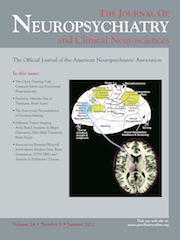Catatonic Schizophrenia With Cavum Septum Pellucidum
To the Editor: Cavum septum pellucidum (CSP), a space between the two leaflets of the septi pellucidi, is thought to be a neurodevelopmental anomaly associated with schizophrenia. Its prevalence rate has been considered to be highly variable in schizophrenia.1–3
This is the case of a 40-year-old lady diagnosed with chronic psychotic illness, with onset at the age of 35 years. She presented with a 5-year history of social withdrawal, poor speech output, amotivation, decreased self-care, occasional muttering to self, and impaired functioning in social and family context. Her history revealed that she had a continuous illness with exacerbations characterized by predominant catatonic symptoms of poor speech output, standing in a particular posture for prolonged periods. On admission, she was found to be nearly mute, had posturing, interacted very little with others and had impaired self-care. There was no history suggestive of pervasive mood symptoms during this time. She was never treated with psychotropic drugs in the past. Family history was not significant; premorbid personality revealed schizoid personality traits. General physical examination was within normal limits. Hemogram and metabolic profile did not show any abnormality. Bush Francis Catatonia rating scale (BFCRS) score and Brief Psychiatric Rating Scale(BPRS) score at admission were 9 and 37, respectively. CT of the brain revealed a large cavum septum pellucidum. There were no other abnormalities detectable in the form of focal findings or significant volume loss.
She was treated with injected lorazepam 2 mg iv tid for 3 days, and later oral lorazepam was continued on a tapering dosage for 2 weeks. She was also started on tablet risperidone up to 6 mg per day along with tablet trihexyphenidyl. The catatonic symptoms resolved in 1 week, with a BFCRS rating of 0 at this point. At the end of 5 weeks, the patient was better, with improvement in self-care and social interactions and reduction in hallucinatory behavior. The BPRS score at the end of the 5th week was 9.
The factors associated with this anomaly are early age at onset,4 chronicity5 and female gender.4 However, there are no reports of its occurrence in catatonic schizophrenia. This structure is closely linked developmentally to the fronto- limbic system, which has been implicated in the etiology of the disorder. It would be interesting to examine the relationship between the subtypes of schizophrenia and its relationship with neuro-developmental abnormalities such as cavum septum pellucidum.
1 : Increased prevalence of cavum septum pellucidum in schizophrenia. Psychiatry Res 1993; 50:193–199Crossref, Medline, Google Scholar
2 : Increased prevalence of the cavum septum pellucidum in magnetic resonance scans and post-mortem brains of schizophrenic patients. Psychiatry Res 1992; 45:1–13Crossref, Medline, Google Scholar
3 : Magnetic resonance imaging study of the cavum septi pellucidi in patients with schizophrenia. Am J Psychiatry 2001; 158:1717–1719Crossref, Medline, Google Scholar
4 : Cavum septum pellucidum and its increased prevalence in schizophrenia: a neuroembryological classification. J Neuropsychiatry Clin Neurosci 2004; 16:41–46Link, Google Scholar
5 : MRI study of cavum septi pellucidi in schizophrenia, affective disorder, and schizotypal personality disorder. Am J Psychiatry 1998; 155:509–515Crossref, Medline, Google Scholar



